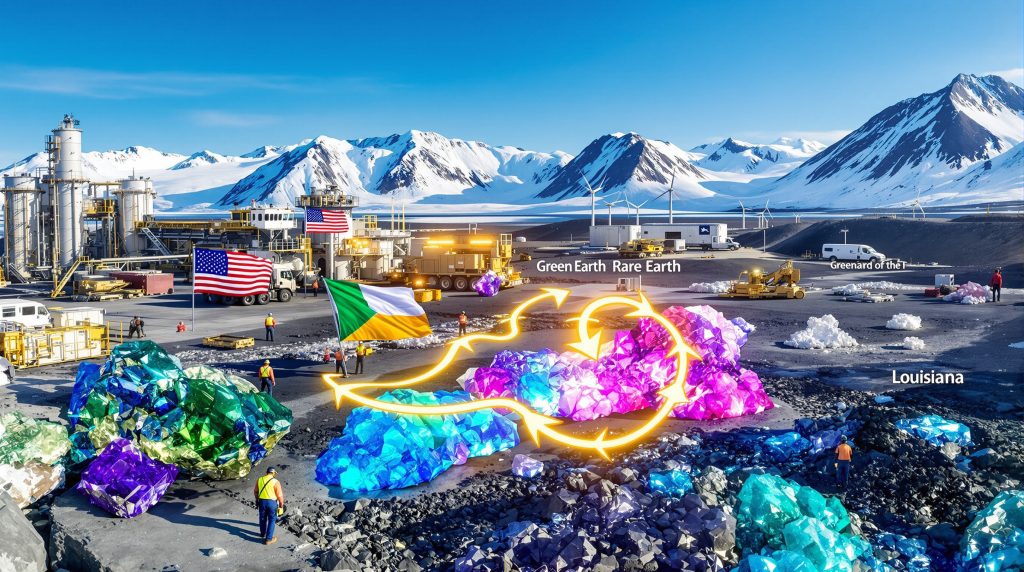Critical Metals' Strategic 10-Year Rare Earth Supply Agreement: Implications for US Supply Chain Security
Critical Metals has signed a pivotal 10-year agreement to supply heavy rare earth concentrate to Ucore Rare Metals' Louisiana processing facility, marking a significant step toward reducing American dependence on Chinese rare earth supplies. This strategic partnership represents a cornerstone in the evolving landscape of critical minerals energy transition and highlights growing efforts to establish domestic processing capabilities for these vital resources.
What is the Critical Metals-Ucore Rare Earth Supply Agreement?
The agreement between Critical Metals and Ucore Rare Metals establishes a decade-long supply partnership focused on heavy rare earth concentrate from Greenland's Tanbreez project. This arrangement promises to deliver up to 10,000 metric tons of heavy rare earth concentrate annually to Ucore's Louisiana processing facility, representing approximately 10% of the Tanbreez project's initial projected production capacity.
Key Terms of the 10-Year Supply Contract
The agreement's cornerstone is the substantial annual supply volume—10,000 metric tons of heavy rare earth concentrate—which will provide Ucore with a consistent, non-Chinese source of these strategic materials. This long-term arrangement offers stability for both parties and creates a foundation for a resilient supply chain outside Chinese control.
The agreement specifies that materials will undergo processing at Ucore's Louisiana facility, where raw concentrate will be transformed into high-purity rare earth oxides suitable for advanced manufacturing applications. This value-added step is crucial for establishing a complete supply chain within North America.
By spanning a full decade, the contract provides the long-term certainty needed for major infrastructure investments and business planning. This duration also signals confidence in the project's viability and the long-term market for rare earth elements.
Strategic Significance for US Critical Minerals Policy
This agreement directly addresses urgent US government initiatives to reduce dependence on Chinese rare earth supplies, which currently dominate global processing capacity. The partnership aligns perfectly with broader national security objectives that have identified critical mineral sourcing as a strategic vulnerability requiring immediate attention.
The deal represents a milestone in developing alternative rare earth supply chains that can operate independently of Chinese influence or potential export restrictions. By connecting Greenland-sourced materials with US processing capabilities, the agreement creates an entirely new supply pathway.
This arrangement supports the broader US strategy to diversify critical mineral sources beyond Chinese control, which has become increasingly important as trade tensions and US mineral production order have highlighted supply vulnerabilities. The partnership demonstrates how public-private cooperation can accelerate the development of secure supply chains for strategic materials.
How Does the Tanbreez Project Support US Rare Earth Security?
The Tanbreez rare earth project in Greenland stands as a cornerstone in efforts to establish non-Chinese rare earth supply chains. With substantial production capacity and strategic backing from US government institutions, the project represents a significant advancement in securing these critical materials for American industries and defense applications.
Tanbreez Project Overview and Production Capacity
Located in southern Greenland, the Tanbreez project offers a geopolitically secure source of rare earth elements outside Chinese control. The project's strategic location provides supply chain diversification in a politically stable region aligned with Western interests.
Development costs for the Tanbreez project are estimated at $290 million, a substantial investment that reflects the project's scale and significance. This figure encompasses mining infrastructure, processing facilities, and associated logistics networks necessary to bring the project online.
When fully operational, the Tanbreez project is expected to produce approximately 85,000 metric tons of rare earth concentrate annually, making it one of the largest non-Chinese sources of these critical materials globally. This production volume could significantly alter global supply dynamics for rare earth elements.
The project's economic fundamentals appear robust, with a Preliminary Economic Assessment (PEA) valuing the project at approximately $3 billion. This valuation reflects both the project's substantial reserves and the strategic premium placed on non-Chinese rare earth sources.
Beyond rare earth elements, the Tanbreez project will also produce two minor metals as byproducts, adding additional revenue streams and enhancing the project's overall economics. This diversified production profile strengthens the business case for development.
Financial Backing and Development Timeline
In a significant vote of confidence, the US Export-Import Bank (EXIM) issued a letter of interest for up to $120 million in financing for the project in June. This potential loan package demonstrates the strategic importance placed on developing alternative rare earth sources by US authorities.
The financing represents the administration's first overseas mining investment, highlighting the project's alignment with national security objectives and defence-critical materials strategy. This precedent-setting financial support demonstrates a shift in US policy toward more direct involvement in securing upstream mineral resources.
This funding structure showcases the US government's commitment to securing rare earth supplies through tangible financial backing rather than mere policy statements. The EXIM involvement helps overcome the significant capital barriers that have historically hindered development of new rare earth projects outside China.
For Greenland, the project represents a significant foreign direct investment in its mining sector, potentially transforming the local economy while establishing the island as a strategic supplier of critical minerals. This economic development opportunity aligns with Greenland's interest in developing its natural resources for economic diversification.
Why Are Rare Earth Elements Critical to US National Security?
Rare earth elements play an indispensable role in modern defense systems, renewable energy technologies, and advanced electronics. Their unique properties make them irreplaceable in many applications, while current supply chains remain vulnerable to disruption, creating significant strategic concerns for US policymakers and defense planners.
Strategic Applications of Rare Earth Elements
Rare earth elements serve as essential components in permanent magnets that convert power to motion in countless military and civilian applications. These magnets provide unmatched performance in miniaturized, lightweight systems where efficiency is paramount.
In defense technologies, rare earths are critical for guidance systems, radar, sonar, communications equipment, and electronic warfare capabilities. Without secure access to these materials, military readiness and technological superiority could be compromised.
The renewable energy sector depends heavily on rare earth elements, particularly for wind turbines, where neodymium magnets enable efficient electricity generation in compact designs. As renewable energy deployment accelerates, demand for these materials continues to grow.
Electric vehicle production relies extensively on rare earth magnets for motors and generators, with each EV containing several kilograms of these critical materials. The automotive industry's transition toward electrification is significantly increasing demand for rare earth elements.
Beyond these applications, rare earths are necessary for numerous high-tech products with national security implications, including night vision equipment, precision-guided munitions, satellite systems, and advanced computing hardware. Their strategic importance extends across virtually all advanced technology domains.
Current Global Supply Chain Vulnerabilities
China currently controls approximately 80% of global rare earth processing capacity, creating a profound strategic vulnerability for Western nations. This dominance extends across mining, processing, and magnet manufacturing, giving China unprecedented leverage over global technology supply chains.
In March, China imposed export restrictions on rare earth materials, highlighting the fragility of current supply arrangements and sending shockwaves through manufacturing sectors dependent on these materials. These restrictions demonstrated how quickly access to critical materials can be jeopardized by geopolitical tensions.
Ongoing trade tensions have repeatedly underscored US dependence on foreign rare earth sources, particularly as technology competition between the US and China intensifies. Supply chain security has consequently emerged as a top-tier national security concern.
The limited domestic processing capacity within the US creates a strategic weakness even when raw materials are available from friendly nations. Without the ability to transform raw materials into usable forms, upstream supply diversification provides limited security benefits.
These vulnerabilities led to rare earth elements being classified as critical minerals due to their supply risk and importance to economic and national security. This designation has triggered policy initiatives to address supply chain weaknesses through domestic production, processing, and stockpiling efforts.
What Role Will Ucore's Louisiana Facility Play in the Supply Chain?
Ucore's Louisiana rare earth processing facility represents a critical missing link in the North American rare earth supply chain. With substantial government backing and phased development plans, the facility aims to establish domestic processing capabilities for these strategic materials, reducing dependence on overseas refineries.
Louisiana Processing Facility Development
The facility has received substantial government support, including $18.4 million from the US Defense Department for its first construction phase. This funding underscores the strategic importance placed on developing domestic processing capabilities for rare earth elements.
Engineered specifically to process heavy rare earth concentrate into high-purity oxides, the facility addresses a critical gap in the domestic supply chain. This specialized capability has been almost entirely absent from North America, forcing reliance on overseas processing.
Initial production capacity is targeted at 2,000 tonnes per annum (tpa) of rare earth oxides, with operations expected to commence in 2026. This first phase will establish proof of concept while beginning to address immediate supply needs for defense and commercial applications.
The facility's designers have incorporated significant expansion potential, with planned capacity increases to 7,500 tpa by 2028. This phased growth approach allows for optimization of processes and market alignment as operations mature.
This development represents a significant milestone in rebuilding domestic processing capabilities that have been largely absent from the US industrial landscape for decades. By reestablishing these technical competencies, the facility helps address a strategic vulnerability in critical material supply chains.
Processing Technology and Capabilities
The facility will specialize in converting raw rare earth concentrate into separated rare earth oxides through advanced extraction and separation processes. These high-purity products serve as the essential feedstock for downstream manufacturing of magnets and other components.
With a focus on heavy rare earths, which are typically more valuable and scarce than their light rare earth counterparts, the facility targets the most strategically significant materials in the rare earth family. Elements like dysprosium and terbium command premium prices while facing severe supply constraints.
By producing separated oxides domestically, the facility creates value-added products for US manufacturing, enabling a more complete domestic supply chain. This vertical integration reduces vulnerability to overseas processing bottlenecks.
The facility's operations will significantly reduce dependence on foreign processing facilities, particularly those in China, which currently dominate global separation capacity. This diversification provides crucial redundancy for critical material processing.
In the rare earth supply chain, processing represents the critical middle step between mining and magnet manufacturing, often referred to as the "bottleneck" in non-Chinese supply development. By addressing this specific vulnerability, the Louisiana facility fills a crucial gap in supply chain security.
How Does This Agreement Impact Global Rare Earth Markets?
The Critical Metals-Ucore agreement signals shifting dynamics in global rare earth markets, with potential long-term implications for pricing, competition, and supply chain development. As one of several emerging alternatives to Chinese dominance, this partnership contributes to gradual but meaningful changes in market structure.
Market Implications and Supply Diversification
This agreement signals growing competition to China's rare earth dominance, potentially reducing its ability to control global markets through production quotas or export restrictions. As alternative sources develop, market power becomes more distributed among multiple suppliers.
The partnership may influence global pricing and availability of rare earth elements by introducing significant non-Chinese supply into Western markets. This competition could moderate price volatility and reduce risk premiums currently associated with supply uncertainty.
By creating new supply routes for Western manufacturers, the agreement helps establish more resilient supply chains for industries dependent on rare earth elements. Manufacturers gain optionality in sourcing, reducing vulnerability to single-source disruptions.
Market volatility, historically a challenge for rare earth consumers, may be reduced through diversified sourcing options. More stable pricing environments encourage investment in technologies that utilize rare earth elements by reducing financial risks associated with input cost fluctuations.
The agreement establishes a precedent for future non-Chinese supply arrangements, potentially catalyzing additional partnerships between resource developers and processors. This demonstration effect could accelerate supply chain diversification beyond this single project.
Comparative Analysis of Global Rare Earth Projects
The Tanbreez project positions as one of the largest non-Chinese rare earth developments in the global pipeline, with production capacity that could meaningfully impact global supply balances. Its scale exceeds most other Western projects currently under development.
Compared to other Western rare earth initiatives, the project's scale and advancement place it among the most significant near-term prospects. While numerous projects have been proposed globally, few have secured similar levels of financial backing and offtake arrangements.
The project's projected timeline aligns with forecasted increases in global rare earth demand, particularly for heavy rare earths used in permanent magnets. This timing could allow the project to enter the market during a period of supply deficit.
The Tanbreez deposit's concentrate quality and composition offers competitive advantages in certain rare earth elements, particularly some heavy rare earths that command premium prices. These compositional differences affect processing economics and market positioning.
Geographically, the project provides important supply diversification benefits, being located in Greenland rather than concentrated in existing production centers. This geographic distribution reduces vulnerability to localized disruptions from natural disasters, political instability, or logistical challenges.
What Challenges Remain for Rare Earth Supply Chain Development?
Despite progress represented by the Critical Metals-Ucore agreement, significant challenges remain in establishing robust, competitive rare earth supply chains outside China. Technical, logistical, economic, and regulatory hurdles must be overcome to achieve true supply chain security for these strategic materials.
Technical and Logistical Considerations
Processing rare earths requires sophisticated technology and expertise that has largely developed in China over recent decades. Rebuilding this technical capability in Western facilities involves significant knowledge transfer challenges and workforce development needs.
Transportation logistics between Greenland and Louisiana present meaningful challenges, requiring coordination of shipping routes, handling procedures, and inventory management across substantial distances. These logistical complexities add costs and potential vulnerabilities to the supply chain.
Scaling production from laboratory or pilot levels to full commercial operation involves significant technical complexity for both mining and processing operations. This scale-up process frequently encounters unexpected challenges requiring technical adaptations.
Environmental considerations in both mining and processing operations demand sophisticated management systems and monitoring protocols. Rare earth processing typically generates radioactive waste streams and chemical byproducts requiring careful handling.
Quality control and consistency requirements for high-tech applications impose rigorous standards on rare earth production, as even minor variations in purity or composition can affect performance in sensitive applications. Meeting these specifications consistently at commercial scale presents ongoing challenges.
Economic and Regulatory Factors
Fluctuating rare earth prices create uncertainty in long-term project economics, complicating investment decisions and financing arrangements. Historical price volatility has deterred investment in new production capacity outside China.
Regulatory approvals across multiple jurisdictions add complexity and potential delays to project development. Mining operations in Greenland and processing facilities in Louisiana must navigate different regulatory frameworks with varying requirements.
Competition from other emerging rare earth projects globally creates market uncertainty, as multiple projects advancing simultaneously could lead to oversupply in certain market segments. Project developers must carefully assess competitive positioning and target markets.
Cost competitiveness compared to established Chinese operations remains challenging, as decades of development and government support have created significant advantages for Chinese producers. New entrants must overcome this cost disadvantage through technical innovation or strategic positioning.
Balancing commercial viability with strategic imperatives creates tension in project development and operations. While national security considerations may justify premium pricing or government support, long-term commercial sustainability requires competitive cost structures.
What Are the Long-Term Implications for US Critical Mineral Strategy?
The Critical Metals-Ucore agreement represents a significant milestone in developing a more resilient critical minerals strategy for the United States. Its success could catalyze additional investments and partnerships while establishing frameworks for addressing similar vulnerabilities in other strategic materials.
Future Outlook for US Rare Earth Supply Chain
This agreement represents a significant step toward supply chain resilience, potentially catalyzing additional investments in mining, processing, and manufacturing capacity. Success in this partnership could demonstrate commercial viability for similar ventures.
By establishing reliable sources of processed rare earth materials, the agreement creates a foundation for domestic manufacturing of rare earth-dependent products such as magnets, motors, and electronics. This downstream development could generate significant economic benefits while enhancing supply security.
The partnership may encourage additional investment in US processing capabilities as success demonstrates commercial viability and reduces perceived risks. This demonstration effect could accelerate capital formation for similar projects addressing other critical mineral vulnerabilities.
This public-private partnership establishes a model for future critical mineral development, combining government support with private sector execution. The framework created could be replicated for other strategic materials facing similar supply challenges.
Through practical implementation, this agreement demonstrates the viability of non-Chinese rare earth supply chains, potentially shifting industry perceptions about supply diversification possibilities. This proof of concept could accelerate market transformation beyond government mandates.
Policy Recommendations for Strengthening Critical Mineral Security
To build on this progress, continued investment in domestic processing capabilities across the entire rare earth value chain would strengthen supply security. Particular focus should be placed on magnet manufacturing, where strategic vulnerabilities remain most acute.
Development of rare earth recycling technologies and infrastructure would complement primary production by creating circular supply loops less vulnerable to geopolitical disruptions. Recovery from end-of-life products offers significant untapped potential for domestic supply.
Workforce development for specialized technical expertise in rare earth processing, metallurgy, and advanced manufacturing should be prioritized through educational programs, industrial partnerships, and knowledge transfer initiatives. Human capital represents a significant constraint on rapid industry development.
International partnerships with allied nations for supply diversification would create redundant supply networks with greater resilience than any single national approach. Coordination with partners like Australia, Canada, and European CRM facility could accelerate progress.
Research into alternative materials to reduce rare earth dependence represents a complementary strategy that could reduce vulnerability through substitution rather than supply diversification. Materials science breakthroughs could potentially alleviate critical dependencies in specific applications.
FAQs About the Critical Metals-Ucore Agreement
What are rare earth elements and why are they important?
Rare earth elements comprise 17 metals with unique magnetic, luminescent, and electrochemical properties. Despite their name, most are relatively abundant in Earth's crust but rarely found in concentrated, economically viable deposits. They're essential for technologies ranging from smartphones and electric vehicles to military systems and renewable energy infrastructure.
How does this agreement reduce US dependence on Chinese rare earths?
By establishing a 10-year supply agreement from a non-Chinese source (Greenland) to a US processing facility, the agreement creates an alternative supply chain completely outside Chinese control. This diversification reduces vulnerability to potential supply disruptions or export restrictions from China.
What is the significance of the US Export-Import Bank's involvement?
The $120 million loan interest from EXIM represents unprecedented US government financial support for an overseas mining project, signaling the strategic importance of rare earth elements to national security and economic interests. This financing helps overcome the significant capital barriers to developing new rare earth sources.
When will the Tanbreez project begin production?
While specific production timelines weren't detailed in the announcement, mining projects of this scale typically require several years for development following financing. The Ucore processing facility is expected to begin operations in 2026, suggesting the supply chain should be operational by mid-decade.
Which industries will benefit most from this new supply chain?
Defense contractors, electric vehicle manufacturers, renewable energy developers, and electronics producers stand to benefit most directly from diversified rare earth supplies. These industries face particular vulnerability to supply disruptions due to their reliance on rare earth components in critical applications.
How does this agreement compare to other rare earth development initiatives?
This agreement represents one of the most significant and concrete steps toward rare earth supply chain diversification to date, with specific volume commitments, identified processing facilities, and government financial backing. While numerous projects have been proposed globally, few have progressed to firm supply agreements with processing partners.
What environmental considerations are involved in rare earth production?
Rare earth mining and processing present significant environmental challenges, including potential radioactive waste management, chemical processing effluents, and habitat disruption. Modern operations typically implement extensive environmental controls, though these add to production costs and complexity.
Further Exploration
The Critical Metals-Ucore agreement represents a significant milestone in efforts to develop resilient supply chains for strategic minerals. Its implementation will test whether commercial-scale rare earth production and processing can be economically viable outside China while meeting stringent environmental and quality standards. Success could catalyze similar developments across the critical minerals landscape, while challenges could highlight the need for additional policy support or technical innovation.
The partnership also demonstrates evolving approaches to critical mineral security, combining private sector development with strategic government support. This hybrid model may prove instructive for addressing vulnerabilities in other material supply chains essential to economic and national security.
As global competition for critical minerals intensifies, this agreement positions the United States to reduce a significant strategic vulnerability while creating domestic economic opportunities. The coming years will demonstrate whether this approach can effectively counter decades of supply chain consolidation and create truly resilient alternatives for these essential materials, potentially serving as a model for Australia's strategic reserve of Critical Metals agreement to supply rare earth to US government.
Want to Capitalise on the Next Major Mineral Discovery?
Stay ahead of the market with Discovery Alert's proprietary Discovery IQ model, which instantly notifies investors of significant ASX mineral discoveries and transforms complex data into actionable insights. Understand why historic discoveries can generate substantial returns by visiting Discovery Alert's dedicated discoveries page and begin your 30-day free trial today.




